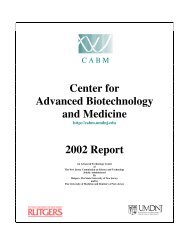Annual Report 2011 - Center for Advanced Biotechnology and ...
Annual Report 2011 - Center for Advanced Biotechnology and ...
Annual Report 2011 - Center for Advanced Biotechnology and ...
Create successful ePaper yourself
Turn your PDF publications into a flip-book with our unique Google optimized e-Paper software.
Dr. Joseph Marcotrigiano<br />
CABM Resident Faculty Member<br />
Assistant Professor<br />
Department of Chemistry <strong>and</strong><br />
Chemical Biology<br />
Rutgers University<br />
Dr. Abdul Khan<br />
Postdoctoral Assoc.<br />
Ankita Basant<br />
Graduate Student<br />
Fuguo Jiang<br />
Graduate Student<br />
Jillian Whidby<br />
Graduate Student<br />
Samantha Yost<br />
Graduate Student<br />
Structural Microbiology Laboratory<br />
Dr. Joseph Marcotrigiano obtained his B.A. from Rutgers with highest<br />
honors <strong>for</strong> research on the structure of HIV-1 RT <strong>and</strong> intergrase as a Henry<br />
Rutgers Undergraduate Scholar. He received the National Starch Award<br />
<strong>and</strong> the Bruce Garth Award <strong>for</strong> highest st<strong>and</strong>ing in the chemistry program<br />
<strong>and</strong> was selected <strong>for</strong> a graduate fellowship at Rockefeller University. He<br />
completed Ph.D. studies with Dr. Stephen Burley in 2000 <strong>and</strong> was awarded<br />
the inaugural David Rockefeller Jr. Alumni Fellowship. He conducted<br />
postdoctoral research as a Merck Fellow of the Life Sciences Research<br />
Foundation in the <strong>Center</strong> <strong>for</strong> the Study of Hepatitis C with Dr. Charles Rice<br />
at Rockefeller University. Dr. Marcotrigiano joined CABM in 2007.<br />
.<br />
Hepatitis C virus (HCV) continues to be a major public health problem. In most<br />
cases, HCV infection becomes chronic <strong>and</strong> can persist <strong>for</strong> decades, leading to<br />
cirrhosis, end-stage liver disease <strong>and</strong> hepatocellular carcinoma. Currently, 2% of the<br />
human population – approximately 123 million people – is infected with HCV. In<br />
fact, there are 3-4 times more individuals infected with HCV than HIV, making virus<br />
transmission a major public health concern. In the United States, HCV infection is<br />
the most common cause of liver transplantation <strong>and</strong> results in 10,000 to 20,000<br />
deaths a year. There is no vaccine, <strong>and</strong> current HCV therapy, pegylated interferonalpha<br />
in combination with ribavirin, leads to a sustained response in only 50% of<br />
genotype 1-infected patients, the prevalent genotype in the United States. The<br />
current HCV treatment stimulates the patient’s immune system to clear the virus, but<br />
numerous side effects cause many patients to prematurely stop treatment. Given the<br />
high prevalence of infection <strong>and</strong> poor response rate, inhibitors that specifically target<br />
HCV proteins with fewer side effects are desperately needed. In addition, an<br />
effective vaccine would greatly reduce the spread of the virus.<br />
Our laboratory studies how HCV enters a host cell <strong>and</strong> avoids the cellular innate<br />
immune response to infection. To elucidate these processes we employ a variety of<br />
structural, biophysical, biochemical <strong>and</strong> virological techniques. HCV is a member<br />
of the family Flaviviridae, which also includes Pestiviruses <strong>and</strong> Flaviviruses.<br />
51



